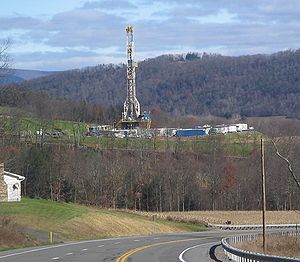A new, never-before-seen type of bacteria has been found inside oil shale and natural gas wells.

[Translation by Dr. Nachmani Moshe]
Researchers who examined the genomes of microorganisms living inside oil shale and gas wells found proof of the flourishing of sustainable ecosystems there - and even a new type of bacteria that had never been observed, which the researchers called 'Frackibacter'. The new type is one of 31 types of bacteria found inside two separate drillings using the hydraulic fracturing method. The research findings were published by scientists from Ohio University in the online version of the scientific journal Nature Microbiology. Despite the fact that the wells were hundreds of kilometers apart and were drilled in different shale formations, the bacterial colonies found there were almost identical, say the researchers. Almost all the bacteria that the researchers found have been observed in other places in the past, and it is likely that many of them originate from the pools of water that the energy companies mined in order to fill the wells; However, this is not the case with the newly discovered strain, Candidatus Frackibacter, which may be unique to hydraulic fracturing drilling sites, said researcher Kelly Wrighton, a professor of microbiology and biophysics at Ohio State University. In terms of nomenclature in biology, the term "Candidatus" indicates that a new organism has been studied for the first time ever using a genomic approach, and that the organism was not isolated from a laboratory culture.
The researchers chose the name "Frackibacter" for the new species, inspired by the word "fracking", short for the method of hydraulic fracturing. "We believe that the bacteria in the boreholes may create an independent eco-environment, where they provide the food sources for themselves," said the lead researcher. "The drilling of the well and pumping with the help of fracturing fluid create the eco-environment, but the bacteria adapt to their new environment in such a way that allows them to preserve the environment for long periods of time." By taking fluid samples from two wells over 328 days, the researchers were able to decipher the genomes of bacteria and archaeons (prokaryotic microorganisms) living in the oil shale. To the researchers' surprise, almost identical bacterial colonies developed in the two separate sites. In addition, the two wells were owned by different energy companies that used different fracturing methods. Both types of shale were found about two kilometers deep in the ground, were formed millions of years apart, and included different types of fossil fuels. And yet, one type of bacteria, Halanaerobium, became dominant in the two very different sites. "We thought in advance that we might find similar types of bacteria, but the level of similarity was so high that it completely surprised us. This finding suggests that what happens in these eco-environments is more influenced by the fracturing process than by the inherent differences in the shale," said the lead researcher. The researchers still do not know for sure what the source of the bacteria is. Some of them, almost certainly, came from the ponds that provided water for the wells, says the researcher. However, other types of bacteria and archaea lived in the rock layer even before the drilling process began.
Oil shale energy production companies independently develop the fluids they inject into these wells in order to crack and break up the rock layer and release the gas or oil stored in them, explains the lead author of the article published in the scientific journal Nature Microbiology. All these liquids are based on water to which other chemicals are added. The microorganisms living inside the shale must survive high temperatures, pressure and salinity, but this study suggests that the level of salinity is the most important constraint to the survival of the bacteria. The high salinity forces the bacteria to synthesize special organic molecules (osmoprotectants) that prevent them from hatching as a result of this level of salinity. When the cells are destroyed, these substances are released into the water, where they are used as protective substances for other bacteria or as nutrients for them. In this way, the salinity forces the bacteria to create sustainable food sources for themselves. In addition to the physical constraints from the environment, the bacteria must also protect themselves from viruses. The researchers also decoded the genomes of the viruses living inside the boreholes, and found genetic evidence that some of the bacteria were indeed used as food for the viruses, while releasing the protective substances against the salinity into the water. To confirm their findings, the researchers grew the same bacteria in the laboratory under similar conditions. These bacteria also produced the same protective substances (osmoprotectants) that were later converted to methane - a finding that suggests that the researchers are on the right track to understanding the mechanism that occurs inside the wells. One of the applications of the research could be that the methane produced by the bacteria living in the shale could be used as additional energy.
